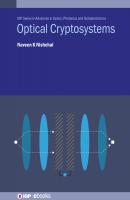Optical Cryptosystems. Naveen K. Nishchal
Чтение книги онлайн.

Читать онлайн книгу Optical Cryptosystems - Naveen K. Nishchal страница 10
Название: Optical Cryptosystems
Автор: Naveen K. Nishchal
Издательство: Ingram
Жанр: Отраслевые издания
isbn: 9780750322201
isbn:
E(x,y)=∬[E1(u,v)×exp{i2πR2(u,v)}]exp2πi(ux+vy)dudv(2.2)
The finally obtained expression, E(x,y), is called the encrypted image. The decryption is the inverse of the encryption process, where all the operational steps described during encryption are performed in reverse. For successful decryption, there are two ways to follow. The first method is to use the conjugate of the respective RPMs in subsequent planes. In this case, the decryption process can be expressed as
E1(u,v)=ℑ[E(x,y)]×exp{−i2πR2(u,v)}(2.3)
f(x,y)=ℑ−1[E1(u,v)]×exp{−i2πR1(x,y)}(2.4)
The symbols ℑ and ℑ−1 denote the Fourier transform and inverse Fourier transform operations, respectively. The second method is to use the conjugate of the encrypted image and respective original RPMs in subsequent planes. In this case, the decryption process can be expressed as
E1(u,v)=ℑ[conj{E(x,y)}]×exp{i2πR2(u,v)}(2.5)
f(x,y)=ℑ−1[E1(u,v)]×exp{i2πR1(x,y)}(2.6)
It is difficult to generate the conjugate of the physical RPMs. Therefore, the use of the conjugate of the encrypted image is preferred, which can be easily generated through a four-wave mixing setup [11]. However, in the case of opto-electronic implementation through electrically addressed SLM, RPMs and their conjugates can be easily generated digitally and displayed. Another important issue to be discussed is that the use of RPM with the image to be encrypted in the input plane technically is not required for successful decryption. This is a drawback of the DRPE scheme as only Fourier-domain RPM is the required key for the successful retrieval of original data/information. MATLAB codes for a basic DRPE scheme have been given at the end of the chapter.
Statistical properties of the encoded image
It is important to note that the modulus of {f(x,y) × exp[i2πR1(x,y)]} is same as the modulus of f(x,y). Therefore, the image is not encrypted in this case, although the RPM bonded input function {f(x,y) × exp[i2πR1(x,y)]} is a white noise [1]. This is demonstrated by evaluating the ensemble average of this input function on the random function R1(x,y):
<f(x,y)exp[i2πR1(x,y)]f(u,v)exp[−i2πR1(u,v)]>=f(x,y)f(u,v)δx−uδy−v(2.7)
since <exp[i2π[R1(x,y)−R1(u,v)]]>R1=δx−uδy−v where δx−u is the Kronecker symbol. The symbol ‘<>’ denotes the ensemble average. This white noise is nonstationary. If f(x,y) is filtered with a phase-only filter of transfer function exp[i2πR2(u,v)] and impulse response h(x,y), then the obtained encrypted image is easy to decode.
In order to study the statistical properties of the encryption procedure, it is important to analyze the statistical property of the impulse response of a phase-only transfer function with a white noise. The following two properties are discussed.
Property 1:
If h(x,y) is the impulse response of a phase-only transfer function defined by H(υ,μ)=exp[i2πR2(υ,μ)] where R2(υ,μ) is a white noise uniformly distributed in [0,1], then, for all x,y,u,v,ξ,η:
〈h*(x−ξ,y−η)h(p−ξ,q−η)〉b=1N2δx−pδy−q(2.8)
where * denotes the complex conjugate and
δx−p1ifx−p=00otherwiseδy−q1ify−q=00otherwise
Proof:
For the proof of the property, the definition of Fourier transform of any function h(x, y) can be used [3] and hence it is written as
h(x,y)=1N2∑υ=0N−1∑μ=0N−1exp[i2πR2(υ,μ)]exp[i2π(υx+μy)](2.9)
Thus the correlation of h(x,y) is
〈h*(x−ξ,y−η)h(p−ξ,q−η)〉b=1N4∑υ=0N−1∑υ′=0N−1∑μ=0N−1∑μ′=0N−1×<exp[i2π{R2(υ′,μ′)−R2(υ,μ)}]>R2×exp[i2π{υ′(p−ξ)+μ′(q−η)}−{υ(x−ξ)+μ(y−η)}](2.10)
However, since R2(υ,μ) is a white noise uniformly distributed on [0,1],
<exp[i2π{R2(υ′,μ′)−R2(υ,μ)}]>R2=δυ−υ′δμ−μ′(2.11)
Substituting equation (2.11) in (2.10),
〈h*(x−ξ,y−η)h(p−ξ,q−η)〉R2=1N4∑υ=0N−1∑μ=0N−1exp[i2π{υ(p−x)+μ(q−y)}](2.12)
Applying the definition of discrete delta function,
∑υ=0N−1∑μ=0N−1exp[i2π{υ(p−x)+μ(q−y)}]=∑υ=0N−1exp[i2πυ(p−x)]∑μ=0N−1exp[i2πμ(q−y)]=N2δx−pδy−q(2.13)
Thus, the property stated in equation (2.8) is obtained. This property proves that the impulse response of the function exp[i2πR2(υ,μ)] is a stationary white noise.
Property 2:
The encrypted function ψ(x,y) is a stationary white noise with an autocorrelation function given as
<ψ*(x,y)ψ(ξ,η)>=1N2∑u=0N−1∑v=0N−1∣f(u,v)∣2δx−ξδy−η(2.14)
Proof:
ψ(x,y)=∑u=0N−1∑v=0N−1f(u,v)exp[i2πR1(u,v)h(x−u,y−v)](2.15)
Then,
<ψ*(x,y)ψ(ξ,η)>=∑u=0N−1∑v=0N−1∑p=0N−1∑q=0N−1f*(p,q)f(u,v)×<exp[i2π{R1(p,q)−R1(u,v)}]h*(x−p,y−q)h(ξ−u,η−v)>(2.16)
However,
<exp[i2π{R1(p,q)−R1(u,v)}]h*(x−p,y−q)h(ξ−u,η−v)>=<exp[i2π{R1(p,q)−R1(u,v)}]>R1×<h*(x−p,y−q)h(ξ−u,η−v)>R2(2.17)
R1(x,y) is a white noise uniformly distributed in [0,1], thus it can be written as
<exp[i2π{R1(p,q)−R1(u,v)}]>R1=δu−pδv−q(2.18)
Using Property 1 and equation (СКАЧАТЬ